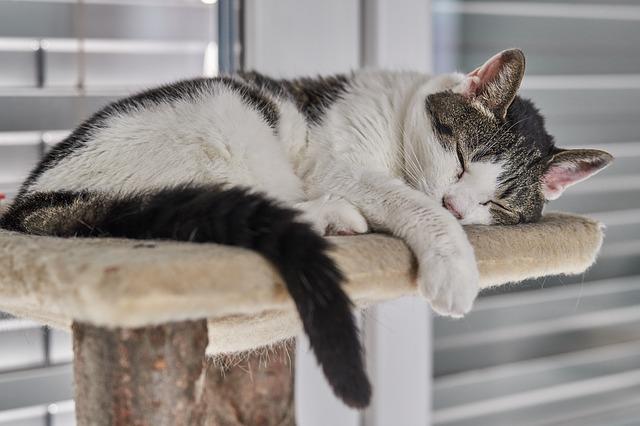Where Do Cats Live: Tips to Provide a Comfortable Environment for Your Cat
Cats are found in many different habitats all over the world. Domestic cats, the most common cat, are typically kept as pets and live in homes with their owners. However, many cats live outdoors, either as feral cats or as outdoor pets. In the wild, cats, like big cats, can be found in various habitats, including forests, grasslands, deserts, and wetlands, according to the National Geographic Society.


Table of Contents
Tips to Provide a Suitable Environment for Your Cat
Plenty of Space
Providing plenty of space for your cat is important to ensure they have room to move around, explore, and engage in natural behaviors like climbing and playing. If you keep your cat indoors, ensure it can access a large, open area to move around. This could be a large room, an enclosed porch, or a cat tree or shelf system that provides vertical space for climbing and perching.
If you have an outdoor cat, make sure they have access to a safe and secure outdoor space. This could be a fenced-in yard, a catio (an enclosed outdoor space specifically for cats), or a harness and leash for supervised outdoor playtime. Cats love to climb and perch, so providing vertical space is important. This could be a tall cat tree, a shelving system, or wall-mounted perches.
Cats also like hiding spots where they can retreat and feel safe. Provide plenty of hiding spots, like a covered bed or a cozy cat cave. If you have multiple cats, provide enough litter boxes to accommodate them all. The general rule of thumb is to provide one litter box per cat plus an extra.
Scratching Posts
Cats like to scratch on various materials, including sisal rope, corrugated cardboard, and carpet. Observe your cat’s scratching habits to determine which material they prefer. Provide at least one scratching post in each area of your home where your cat spends a lot of time. This will encourage them to scratch in appropriate areas instead of on your furniture.
Ensure the scratching post is tall enough for your cat to stretch out fully and scratch. If the post is longer, your cat may not use it. Instead, place the scratching post in an area where your cat likes to scratch, such as near their favorite sleeping spot or near a window where they can watch birds.
Sprinkle some catnip on the scratching post to encourage your cat to use it. When your cat uses the scratching post, reward them with praise, treats, or playtime.
Comfortable Place to Sleep
Many cat beds, including traditional ones, caves, and heated beds, are available. Observe your cat’s sleeping habits to determine which type of bed they prefer. Cats like to have options, so provide multiple sleeping areas in different parts of your home. This will allow your cat to choose the sleeping area that they find most comfortable.


Place the cat bed where your cat feels safe and secure, such as in a quiet corner or near a window with a view. Wash your cat’s bedding regularly to keep it clean and fresh. Cats love soft, cozy blankets to snuggle in, so provide some comfortable blankets for your cat to sleep on. Ensure your cat’s sleeping area is comfortable and not too hot or cold.
Fresh Water and a Balanced Diet
Providing fresh water and a balanced diet is crucial to maintaining your cat’s health and well-being. Ensure your cat has access to fresh, clean water at all times. Change the water daily and clean the water bowl regularly to prevent bacteria buildup. Choose a portion of high-quality cat food appropriate for your cat’s age, health, and lifestyle. Look for food with high-quality protein sources, no artificial colors or preservatives, and is nutritionally balanced.
Avoid overfeeding your cat, as obesity can lead to health problems. Follow the recommended serving size on the cat food packaging and regularly monitor your cat’s weight. Wet food can provide additional moisture in your cat’s diet, which is important for its urinary tract health. Consult your veterinarian to determine if wet food is appropriate for your cat.
Provide various types of food and flavors to keep your cat interested in its diet. For example, or your cat for any signs of food allergies or sensitivities, such as vomiting or diarrhea, and adjust their diet accordingly.
Plenty of Toys and Mental Stimulation
Provide a variety of toys for your cat, including toys that they can bat around, toys that they can chase, and toys that they can chew on. Rotate your cat’s toys regularly to keep them interested and engaged. Interactive toys, such as puzzle feeders or dispensing treats, can stimulate your cat mentally.
Regular play sessions with your cat can provide physical and mental stimulation and can also help strengthen your bond with your cat. Cats love to hide, so provide hiding spots for your cat, such as a cardboard box or a covered cat bed.
Clean and Safe Environment
A clean and safe environment is essential for your cat’s health and well-being. Make sure to clean the litter box at least once a day and replace the litter every two to three weeks. Cats are very clean animals and prefer a clean litter box.


When cleaning your home, use safe cleaning products that are not harmful to your cat. Avoid using products that contain bleach or other harsh chemicals. Keep dangerous items, such as cleaning supplies, medications, and small objects, out of reach of your cat.
If you allow your cat to go outside, ensure they have a safe outdoor area to explore. Provide a secure fence and ensure your cat has identification in case they get lost. Wash your cat’s food and water bowls regularly to prevent bacteria buildup. Ensure your home’s temperature is comfortable for your cat, not too hot or cold.
Opportunities for Socialization
If you have multiple cats, introduce them slowly and carefully. Give each cat space and provide plenty of resources, such as food bowls and litter boxes. Make sure your cat is comfortable around people by introducing them to different people, including friends and family members.
Regular play sessions with humans can provide socialization and mental stimulation for your cat. Attend cat-friendly events in your community, such as cat shows or adoption events, to allow your cat to socialize with other cats and people.
If your cat is social and enjoys the company of other cats, consider adopting another cat to keep them company. Make sure your cat has a comfortable and safe environment where they feel secure and can socialize with others.
